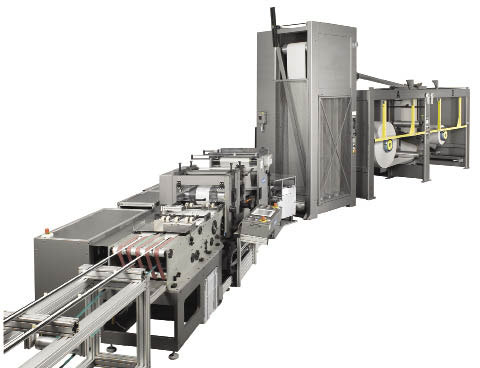Paper, bottle, and can carriers were once the domain of single-piece construction. But this type of beverage carrier is slow to produce and requires a substantial amount of printed high quality cardboard. A newer two-piece carrier design can be produced faster thanks to rotary die cutting technology from Schober USA. Working inline as a “slave” with a folder gluer, the RSM machine operates at speeds of 150 m/min (492 ft/min) and more on a 24/7 basis – producing significantly more beverage carriers than the traditional one-piece design.
A key to the faster production speed is the structured inner frames, which are designed to be integrated into open basket carriers and top-grips. One of the elements for speeding up the production was to replace the current blank feeder at the folder gluer lines by the RSM machines, working inline with the folder gluer.
The inline cutting process of the inner frames allows manufacturers to save raw material by nesting their inner frames, to use lighter weight cardboard supplied on a reel and to eliminate an additional offline inner frame blank die cutting process. By integrating the RSM inline with the folder-gluer a two-step process has become one-step, eliminating unnecessary machine stops.

Additionally, material can be saved with the rotary design, because less gripper waste is generated when the previous sheet fed cutting process is replaced by inline processing with the RSM.
The RSM technology is continuously synchronously driven, which helps maintain precise register accuracy, inline with the folder gluer when merging the inline die cut inner frames with the constantly fed outer parts (already printed/decorated) of the basket carrier. Micrometric die wear compensation adjustment provides cost-effective cutting technology and long service life. In addition to die cutting beverage carriers, RSM technology is suited for a range of papers, films and foils including OPP, PE, PS and PET foil, coated paper laminates, and composites as well as technical non-woven materials.
The RSM family is available with working widths of up to 850 mm (33.5 in). Typical die circumference is 17 in. – 25 in. and in some cases up to 51 in. The RSM machines work either inline – as slave – with web fed printing, converting machines and folder gluers or can be used as stand alone offline version. Their main purpose is cutting, punching and creasing products, in many cases including the stacking of the die cut products.
Schober USA
www.schoberusa.com
Filed Under: Packaging





Tell Us What You Think!